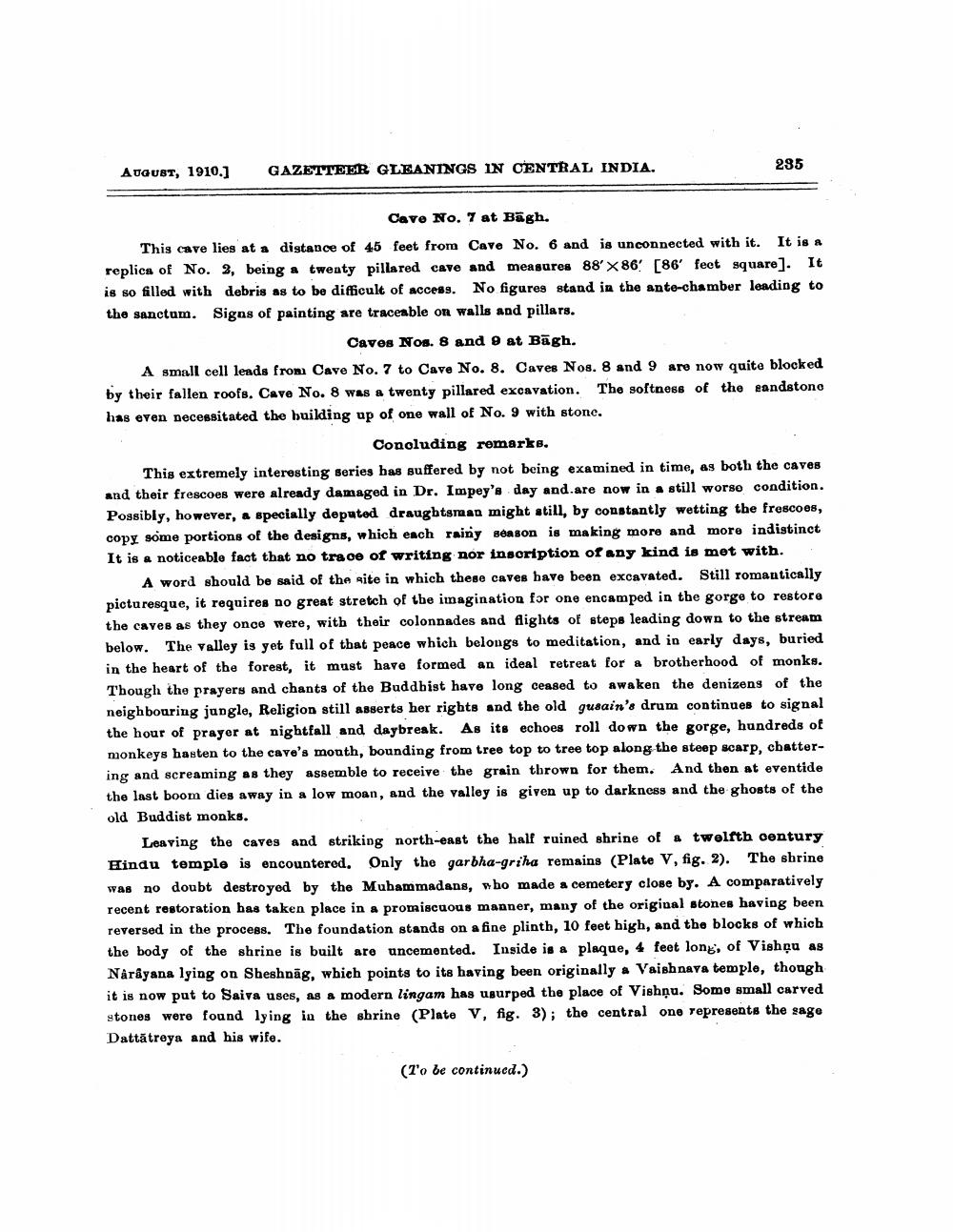________________
AUGUST, 1910.]
GAZETTEER GLEANINGS IN CENTRAL INDIA.
235
Cave No. 7 at Bāgh. This cave lies at a distance of 45 feet from Cave No. 6 and is unconnected with it. It is a replica of No. 2, being a twenty pillared cave and measures 88' X 86' [86' fect square]. It is so filled with debris as to be difficult of access. No figures stand in the ante-chamber leading to the sanctum. Signs of painting are traceable on walls and pillars.
Caves Nos 8 and 9 at Bāgh. A small cell leads from Cave No. 7 to Cave No. 8. Caves Nos. 8 and 9 are now quite blocked by their fallen roofs. Cave No. 8 was a twenty pillared excavation. The softness of the sandstone has even necessitated the building up of one wall of No. 9 with stone.
Conoluding remarks. This extremely interesting series has suffered by not being examined in time, as both the caves and their frescoes were already damaged in Dr. Impey's day and are now in a still worse condition. Possibly, however, a specially deputed draughtsman might still, by constantly wetting the frescoes, copy some portions of the designs, which each rainy season is making more and more indistinct It is a noticeable fact that no trace of writing nor inscription of any kind is met with.
A word should be said of the site in which these caves bave been excavated. Still romantically picturesque, it requires no great stretch of the imagination for one encamped in the gorge to restore the caves as they onco were, with their colonnades and flights of stops leading down to the stream below. The valley is yet full of that peace which belongs to meditation, and in early days, buried in the heart of the forest, it must have formed an ideal retreat for & brotherhood of monks. Though the prayers and chants of the Buddhist have long ceased to awaken the denizens of the neighbouring jangle, Religion still asserts her rights and the old gusain's drum continues to signal the hour of prayer at nightfall and daybreak. As its echoes roll down the gorge, hundreds of monkeys hasten to the cave's mouth, bounding from tree top to tree top along the steep scarp, cbattering and screaming as they assemble to receive the grain thrown for them. And then at eventide the last boom dies away in a low moan, and the valley is given up to darkness and the ghosts of the old Buddist monks.
Leaving the caves and striking north-east the half ruined shrine of a twelfth century Hindu temple is encountered. Only the garbha-griha remains (Plate V, fig. 2). The shrine was no doubt destroyed by the Muhammadans, who made a cemetery close by. A comparatively recent restoration has taken place in a promiscuous manner, many of the original stones having been reversed in the process. The foundation stands on a fine plinth, 10 feet high, and the blocks of which the body of the shrine is built are uncemented. Inside is a plaque, 4 feet long, of Vishga as Nárayana lying on Sheshpãg, which points to its having been originally # Vaishnava temple, though it is now put to Saiva uses, as a modern lingam has ugurped the place of Vishņu. Some small carved stones were found lying in the shrine (Plate V, fig. 3); the central one represents the sage Dattātreya and his wife.
(To be continued.)




